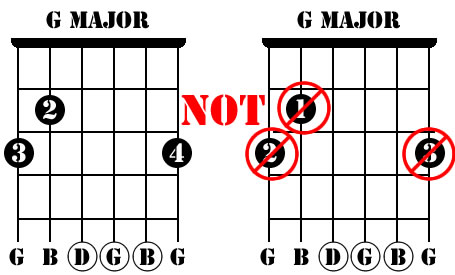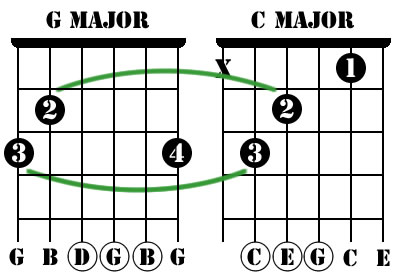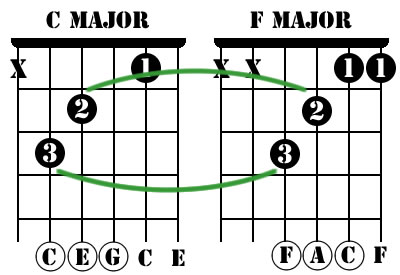Subject: Play Chords Faster With This Tip
You are getting this e-mail because you subscribed to it on www.learn-to-play-rock-guitar.com. If you don't want to receive these e-mails any longer, go to the bottom of this message and click on "unsubscribe." Hey there Friend, This week I'll talk a bit about guitar chords and why it's important to learn the basic chord shapes using the correct fingers. Now that last statement could certainly cause some questions, and there may also be some arguments as to proper fingering of chords. So let me just say right now, the "rules" I'm going to lay down should be looked at as general guidelines for playing guitar chords.There will be exceptions, as there often is in ALL areas of life. Remember people, there isn't a whole lot in this world that you can count on being 100% one way or another. Two for sure are death and taxes, but outside of those dreary topics, the only other "for sure" is that guitar is awesome! We've talked before about the mad contortions we have to teach our fingers to perform as we tackle guitar chords. It definitely true, when our hands and fingers aren't used to being positioned in certain ways, they'll fight us all day long. It takes time and effort to create not only the flexibility in the hands and fingers, but also the muscle memory - so your fingers actually remember where to go when your brain tells them what chords to play. In the meantime, while you're fighting the battle to tame those ornery fingers, it's pretty easy to let frustration take over. Your fingers hurt, your guitar isn't making the cool sounds you know are capable of coming from it and you just want to wing that thing out a window. Calm down, step away from the guitar, slowly, slowly... we don't want you hurting yourself - or the guitar! Calm? OK, so what I'll share with you today won't necessarily make your life and guitar playing easier in the short term, but it will help you become a much more efficient player as you progress. Efficiency. What do I mean? When we start learning guitar chords, being human, we will typically look for the easiest, least painful fingering shape to play a chord. Take for example an open G major chord. Many people will use their their index, middle and ring fingers to fret the chord, putting the index and middle fingers on the fifth and sixth strings respectively, and using the ring finger on the first string. It works, and I've had many of my students show up in their first lesson with me playing their open G major chord in that manner. One thing I watch for when teaching relatively new guitar players is the types of habits they have formed because, like it or not, we all create habits whether they're good... or not-so-good. I bring up the example of the open G major chord because, while it's acceptable to play it using the first three fingers, this isn't the most efficient way to do it. Let's explore this further. If you change the fingers you use to the middle, ring and pinky fingers, with placement on the fifth, sixth and first strings respectively, you are in a far better position to change chords quickly to other common open position chord shapes.  Why is this important? Well, the more efficiently you play, the easier it will be to change chords (another very common problem new guitar players have). Easier chord changes mean faster transitions between chords, which means smoother playing. And smoother playing is what we're after here. You want the song you're playing to actually sound like the song you're playing, right? What happens as you learn to be efficient in your playing is a transformation from focusing on the technical aspects of playing - the how, where and when - to developing a feel for the music. You begin to put the heart and soul into what you are playing. These transfer to your fingers, which translate to your unique, one-of-a-kind tone. If you've ever heard a professional guitarist say that tone is in the fingers, this is what he (or she) is talking about. It's the transfer of the heart and soul of the song from the fingers into the strings and wood of the guitar. This is where the magic comes from. But efficiency is a key component to developing your tone, and it starts here. For guitar chords it starts with learning which fingers to use on each chord. I know it sounds intimidating - that you have to learn how to play all these different chords - but it's really not all that difficult. Hundreds of thousands of guitarists have gone before you and done it, so you can, too. After a while your fingers will remember positions on their own and act on auto-pilot, faithfully executing every order your brain issues... Back to the G Major example. When you fret the chord in the way I explained, your middle and third fingers are on the fifth and sixth strings. Now think about the C Major chord. Where would you place your middle and ring fingers in a C chord? Hmmm, they would go on the fourth and fifth strings, in the same shape as the G major chord. And look, your index finger is already in place to go on the second string on the first fret. Are you starting to see where I'm going with this? You can quickly switch from the G major to C major chord with very little movement.  Now consider how your fingers would have to move if you were using your index and middle fingers on the fifth and sixth strings for G. Quite a difference, wouldn't you agree. When you're just starting out and your fingers aren't used to making precise string changes, this can be extremely frustrating. Don't do that! Make it easy on yourself! Let's go one step further. What if you were going to play an open F major chord (I can hear the groans now)? Guess what, middle and ring fingers are already in position - just move them over one set of strings to the third and fourth strings, respectively. Your index finger is again already in play to barre the first and second strings. And as an added bonus, you have now played all three of the major chords in the key of C major.  With these fingerings, it's not so difficult to switch between each chord. This allows your fingers to get used to the chord changes without having to hunt for string positions. You'll build your speed and confidence, not to mention finger strength and callouses on the finger tips. These are all good things, and believe it or not, with these fingerings you're not too far from other chord shapes. But all in good time... Stay limber, my friends. Peace~ Dave Dave "Eddie" Vance is a rock guitar enthusiast and gear nut. He has been playing guitar for over 30 years and enjoys tormenting the neighbors every chance he gets. When he's not slaving for the man, you can find him rocking out with his B.C. Rich Bich guitar, a cold beer and some sweet tunes. He also runs Learn-To-Play-Rock-Guitar.com, but you knew that already! Follow Learn To Play Rock Guitar:I welcome your feedback! Did you like today's message? What other topics would you like to see covered in my e-mails? Please let me know at: dave@learn-to-play-rock-guitar.com As always, please feel free to forward this email to a friend! I review products before recommending them. If you buy a product based on my recommendation, I will receive a commission. However, my emails also contain links that don’t require any investment on your part and are jam-packed with "juicy, guitar learnin' tastiness". We don't rent or share your name with anybody. Feel free to forward this issue to any friends you think would enjoy its contents. They will thank you. So will I.
|


